**PDF Download:** [SMeyer-CA1227094A1-Hydrogen\_Air\_&\_Non-Combustible\_Gas\_Mixing\_Combustion\_System.pdf](http://stanslegacy.com/attachments/49)
> .Consumer and Consummation - Corporate Affairs Canada at Corporations Canada > > (11) (a) No. 1 227 094 > (45) ISSUED 870922 > (52) CLASS 123-15 C.R. CL. 158-194 > (51) INT. CL. FO2M 21/04ag) ca CANADIAN PATENT «ez > (54) Hydrogen/Air and Non-Combustible Gas Mixing Combustion System > (72) Meyer, Stanley A., U.S.A. > (21) APPLICATION No. 420,889 (22) FILED 830204 No, OF CLAIMS al > > Canada > DISTRIBUTED BY THE PATENT OF CE, OTTAWA SCA27S \[1 1-82) i a ### ABSTRACT An internal combustion engine fuel supply and control that includes apparatus for disassociating hydrogen atoms and oxygen atoms from water and mixing the gas so produced with a non-combustible gas in a predetermined ratio. The gas mixture is mixed with air in suitable proportions and controllably directed to the combustion chamber of the internal combustion engine. ##### HYDROGEN COMBUSTION SYSTEMField of Invention This invention relates to a combustion system and more particularly to one where the combustible gas mixture is hydrogen, oxygen and non-combustible gases.
##### ##### Illustrations:| [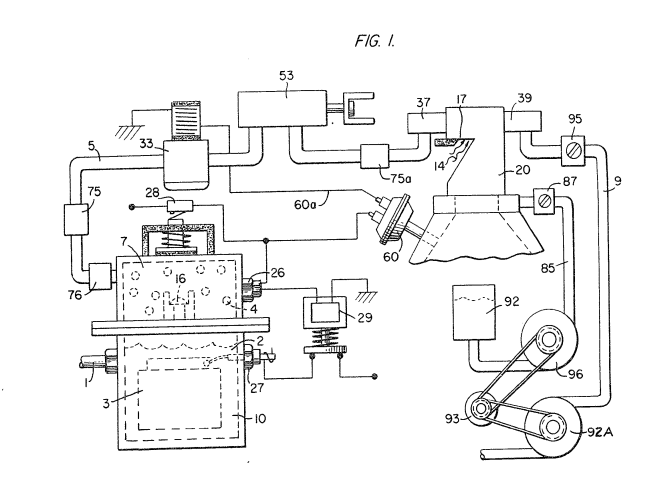](http://stanslegacy.com/uploads/images/gallery/2022-06/CfsvvPVg4tYTTdyK-screenshot-from-2022-06-25-11-56-08.png) | [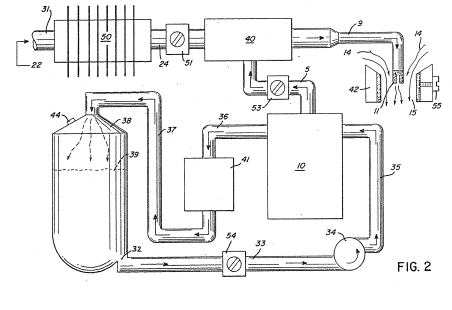](http://stanslegacy.com/uploads/images/gallery/2022-06/NPp61ykQR5nujaJR-screenshot-from-2022-06-25-12-36-24.png) | [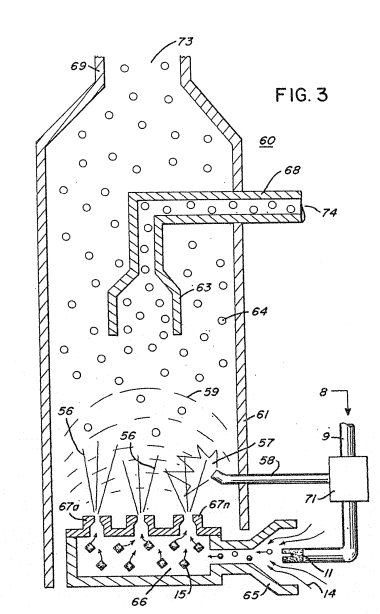](http://stanslegacy.com/uploads/images/gallery/2022-06/AnSHrZ9FQj7j3tKj-screenshot-from-2022-06-25-12-36-51.png) |
| [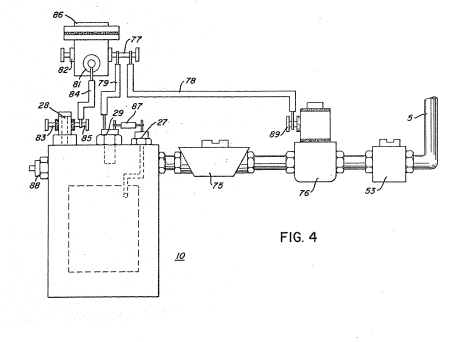](http://stanslegacy.com/uploads/images/gallery/2022-06/ruD25rwycYuz52ft-screenshot-from-2022-06-25-12-37-00.png) | [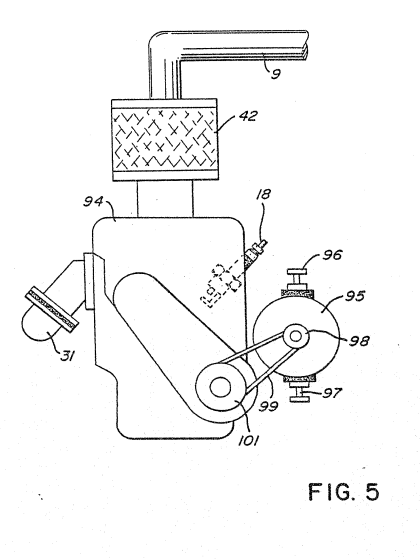](http://stanslegacy.com/uploads/images/gallery/2022-06/sVwmphBBUx3ugzOX-screenshot-from-2022-06-25-12-37-18.png) |
There is disclosed in my co-pending Canadian patent Application Serial No. 420,908, filed February 4, 1983, entitled "**A Hydrogen Generator**" a generating system converting natural water into hydrogen and oxygen gases.
In that system and method, the hydrogen atoms are disassociated from a water molecule by the application of a non-regulated, non-filtered, low-power, direct current voltage electrical potential applied to two non-oxidizing similar metal plates having water passing therebetween. The action is enhanced by pulsing the non-regulated and non-filtered direct current voltage. Particularly significant with my hydrogen generator disclosed in my co-pending application supra is that the hydrogen/oxygen generated is in a quantity in excess of that necessary for practical utilization.Further, **and equally significant** is that the generation of the hydrogen/oxygen is controlled by any one of or combination of several factors:
- varying voltage - varying pulse rate - varying spacing between plates - switching the number of plates - and changing the plate configurationThe hydrogen/oxygen generation is a demand system; that is, the hydrogen/oxygen is **generated only upon the need**. Then, the generation is controlled in quantity by the need; such as, accelerator for an automotive device.
In an earlier hydrogen processor, non-combustible gases are controlled in a mixing stage with a combustible gas. The hydrogen processor system utilizes a rotational mechanical gas displacement system to transfer, meter, mix, and pressurize the various gases. In the gas transformation process, ambient air is passed through an open flame gas burner system to eliminate gases and other present substances. Thereafter, the non-combustible gas-mixture is cooled, filtered for impurity removal, and mechanically mixed with a predetermined amount of hydrogen gas. The gas mixture provides the desired burn-rate. The rotational mechanical gas displacement system in that process determines the quantity by volume of combustible gas mixture to be produced.The above~noted hydrogen processor is a multi-stage system having utility in special applications. The aforementioned co-pending application discloses a very simple and unique hydrogen generator.
#### Summary of Invention The system of the present invention in its preferred embodiment is for a combustion system having utility in a mechanical drive system particularly, in one instance, to drive a piston in an automotive device. The system utilizes the hydrogen generator of my co-pending patent application Serial No. 420,908, for developing hydrogen gas, and other non-combustible gases such as oxygen and nitrogen. The hydrogen gas with the attendant non~combustible gases in a controlled ratio are fed via a line to a controlled air intake system. The combined hydrogen, non-combustible gases, and the air after intermixing are fed to a combustion chamber wherein the mixture is ignited. The exhaust gases of the combustion chamber are returned in a closed loop arrangement to the mixing chamber to provide the non-combustible gases for the mixture. More specifically, generated hydrogen gas is fed to a gas mixing chamber where it is intermixed with non-combustible gases and such gas mixture is then fed to a carburetor (air-mixture) system. The gas mixture is fed through nozzle means in a jet spray in a chamber and a valve or gate controls the amount of air intake to the jet spray. The gas mixture combines with the air to form a combustible mixture of hydrogen, non-combustible gas, and oxygen. The combustible mixture enters into a combustion chamber conventional in design and comprising a cylinder capable of withstanding high pressure. At the uppermost end of the combustion chamber is a spark plug igniter. #### #### Objects A principal object of the present invention is to provide a combustion system utilizing gases combined from a source of combustible and non-combustible gases. Another object of the invention is to provide a combustion system that utilizes hydrogen as the combustible gas and the exhaust of the combustion system as the non-combustible gas. A further object of the present invention is to provide a combustion system of the foregoing in a mechanical drive system. ##### ##### Brief Description of the Drawings: The invention is illustrated by way of example in the accompanying drawings wherein Figure 1 is a schematic, cross-sectional illustration of the present invention in its preferred embodiment; [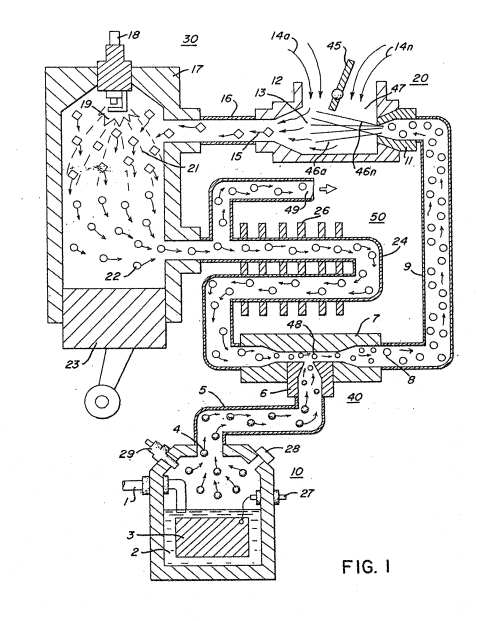](http://stanslegacy.com/uploads/images/gallery/2022-06/TuszVs8KSu0GDmDY-screenshot-from-2022-06-25-12-36-11.png) Figure 2 is a block schematic illustration of the preferred embodiment of Figure 1; [](http://stanslegacy.com/uploads/images/gallery/2022-06/NPp61ykQR5nujaJR-screenshot-from-2022-06-25-12-36-24.png) Figure 3 is an alternative gas system for that shown in Figure i; [](http://stanslegacy.com/uploads/images/gallery/2022-06/AnSHrZ9FQj7j3tKj-screenshot-from-2022-06-25-12-36-51.png) Figure 4 is a block schematic illustration of a gas control system for retrofitting existing automobiles to a combustion system of the present invention; and [](http://stanslegacy.com/uploads/images/gallery/2022-06/ruD25rwycYuz52ft-screenshot-from-2022-06-25-12-37-00.png) Figure 5 is a block schematic illustration of a regenerative energy feedback arrangement according to the present invention. ##### [](http://stanslegacy.com/uploads/images/gallery/2022-06/sVwmphBBUx3ugzOX-screenshot-from-2022-06-25-12-37-18.png) ##### Description of Preferred Embodiments of the Invention [](http://stanslegacy.com/uploads/images/gallery/2022-06/TuszVs8KSu0GDmDY-screenshot-from-2022-06-25-12-36-11.png)Referring particularly to Figure 1 the complete overall combustion system is illustrated together with a mechanical drive piston.Similarly, Figure 2 illustrates the complete system in its preferred embodiment.
[](http://stanslegacy.com/uploads/images/gallery/2022-06/NPp61ykQR5nujaJR-screenshot-from-2022-06-25-12-36-24.png) With particular reference to Figure 1, the hydrogen source 10 is the hydrogen generator disclosed and described in my aforementioned Application Serial No. 420,908 and includes an enclosure for a natural water bath 2. Immersed in the water 2 is an array of plates 3 of similar non-oxidizing material. Applied to plates 3 is a source of pulsed direct current potential via electrical inlet 27. The action of the pulsed direct current, a voltage/current potential, on the plates causes the hydrogen and oxygen atoms to become disassociated from the water molecule. In that the action is not a chemical action, any water irrespective of source may be utilized. Varying either the potential of the direct current source or the pulse rate of the pulsing of the direct current potential will vary proportionately the generation of the hydrogen/oxygen. Other factors are disclosed for varying the output of the generator. The water expended in the generator is replenished from continuous water source l. The hydrogen generator has a safety valve 28 which is rupturable upon excessive gas buildup, Switch 29 is a gas pressure switch to maintain a predetermined gas pressure level above a regulated low-volume. The generated hydrogen gas 4 is Fed via pipe 5 to a gas mixing chamber 7, wherein the hydrogen gas is intermixed with non-combustible gases 22 from a source hereinafter described. The mixture of combustible gas and non-combustible gases are fed via pipe line 9 to a carburetor (air-mixture) system 20. The gas mixture 8 is fed through nozzle 11 to chamber 47 in a jet spray 46. Valve or gate 45 in the air intake controls the amount of air the jet spray 46 of gases combines with to form combustible mixture 15 which comprise hydrogen, non-combustible gases and oxygen. This mixture enters into combustion chamber 30, via pipe line 16. The chamber 30 may be conventional in design comprising a cylinder 17 capable of withstanding high pressure. At the uppermost end of combustion chamber 30 is a Spark plug igniter 18. In a controlled manner, relative to the piston 23 stroke, the spark ignition 19 via plug 18 causes the mixed gases 15 to combust. The compression 21 caused by the combustion, forces the piston 23 to push downwardly in the cylinder 17. The exhaust gases 22, the residue of the combustion 21, now comprise a non-combustible mixture. A portion of these exhaust gases 22 are fed via pipe line 24 to the gas mixing chamber 40 providing the non-combustible gases for mixing with the generated hydrogen gas. The pipe line 24 passes through cooling chamber 50 far cooling of the gases therein. The cooling chamber 50 also functions as a spark arrestor to eliminate the possibility of gas ignition inside the mixing chamber 40. The excess non-combustible gases are exhausted via outlet 49, to be expelled into the atmosphere. [](http://stanslegacy.com/uploads/images/gallery/2022-06/NPp61ykQR5nujaJR-screenshot-from-2022-06-25-12-36-24.png)The apparatus of Figure 2 comprises much the same system as Figure 1. In this embodiment the components are depicted more explicitly in their structural relationship in an alternate arrangement. Basically, the system is operable in the same manner as that in Figure 1, i.e. it utilizes a mixture of combustible (hydrogen) gas and non-combustible gases (exhaust). The hydrogen generator 10, as aforesaid, may be any form of a generator, however, in the preferred embodiment the hydrogen generator is that of my aforementioned co-pending patent application. The water system for the generator is a closed loop system comprising a reservoir oer tank 39 with piping to and from the generator. The reservoir has an outlet 32 connected to a pipe line 33 provided with a water control valve 54 operable to adjust the water Flow rate and a pump 34 connected by pipe line 35 to the generator 10. The overflow water expended and non-expended is expelled from generator 10 into line 36, filtered in filter 41 to remove contaminants and returned to tank 39 via pipe line 37. The gases generated from the water in generator 10 also includes the oxygen component of the water in addition to nitrogen. The outlet 5 on the generator 10 receives the combustible (hydrogen)and non-combustible gases generated thereby and directs the same to the mixing chamber 40. The flow of the hydrogen gas is, of course, critical; therefore, there is incorporated in line 5 a gas Flow valve 53 to adjust the hydrogen gas flow. The exhaust gases entering input 22 are fed via inlet pipe 31 through the cooling chamber also enter the mixing chamber and spark arrestor 50 and into outlet pipe 24. These gases from chamber 50 are flow controlled by flow control valve 51 in pipe line 24. The output of mixing chamber 40, as described relative to Figure 1 is fed via line 9 to a gas mixture system 42. In this instance the intake air 14 may be in a carburetor arrangement with an intake adjustment 55 that adjusts the plate 42 opening. The gas mixture 15 is fad into the carburetor by nozzle 11 and mixed with the air 14. [](http://stanslegacy.com/uploads/images/gallery/2022-06/AnSHrZ9FQj7j3tKj-screenshot-from-2022-06-25-12-36-51.png)With particular reference to Figure 3 there is illustrated an alternative combustion chamber 60 that may be utilized in lieu of the chamber 30 of Figures 1 and 2. In this embodiment the combustible and non-combustible gas mixture that is generated and mixed in the arrangement of Figures 1 and 2, enters inlet 8 and is directed by pipe line 9 and nozzle 11 to the cone 65. The gas mixture combines with air 14 as it enters the cone area 65 and the combined mixture combustible gas 15 is directed by the cone 65 to the dispersing chamber 66. The gas/air mixture 15 is dispersed via ports 67a xxx 67n from the dispersing chamber 66 into the firing area of the combustion chamber 60. The gas mixture entering inlet 8 is also fed by pipe line 9 to a separation chamber 71. This chamber sections off a controlled amount of the intake gas mixture to a pilot light line 58. The pilot light firing gas 57 is also sequenced by the separation chamber 71 such as through an associated mechanical drive, much in the same manner as the cylinder of an automobile engine. The mixture designated gas 56, ejected from ports 67a xxx 67n of the dispersing chamber 66, is ignited by the pilot light and thereby causing combustion 59 of the mainstream gases, As the non-combustible gases 64 (exhaust gases 22 of Figure 1) rise upwardly in the cylinder 61, of the combustion chamber 60, the cone 63 captures a portion of the non-combustible gases 64. The captured exhaust gas is returned via pipe line 68 and outlet 74 to the combustion process as set in Figure 1 or expelled for other purposes. The major portion of the non-combustible gases 64 by-pass the cone 63 and rise further ta the outlet exhaust 69 and are expelled through opening 73. In Figure 4, there is illustrated a gas control system that may be retrofitted to an existing automobile internal combustion engine without changing or modifying its design parameters or characteristics. As low-voltage direct current is applied to safety valve 28, solenoid 86 is activated. ‘The solenoid applies a control voltage to the hydrogen generator plates 26 via terminal 27 through pressure switch 29. As the electrical power activates electric solenoid 86, hydrogen gas is caused to pass through flow adjustment valve 53 and then outlet pipe 5 for utilization. Gas regulator valve 75 is utilized to reduce the pressure level inside the hydrogen generator 10. The pressure differential hydrogen gas output to gas mixing chamber 40 is, for example, 30 lbs. to 15 lbs. Once hydrogen generator 10 reaches an optimum gas pressure level, pressure switch 29 shuts off electrical power to the hydrogen exciters. If the chamber pressure exceeds a predetermined level, the safety release valve 28 is activated disconnecting the electrical current and thereby shutting down the entire system for safety inspection. [](http://stanslegacy.com/uploads/images/gallery/2022-06/sVwmphBBUx3ugzOX-screenshot-from-2022-06-25-12-37-18.png)Similar to an automobile engine or other drive force requiring an electrical energizing source, the. present invention may include the regenerative energy feedback arrangement shown in Figure 5. The process utilizes a mechanical drive system as described relative to Figures 1 and 2; and which mechanical drive may be that of a piston such as utilized in a gasoline engine. In operation, the process mixture is ignited much in the same manner as in Figure 1. ‘The drive mechanism in turn activates electrical voltage of alternator 95 whose output is fed back to the hydrogen generator and utilized as the firing voltage on the spark plug 18; again, in a closed loop arrangement.| [](http://stanslegacy.com/uploads/images/gallery/2022-06/TuszVs8KSu0GDmDY-screenshot-from-2022-06-25-12-36-11.png) | [](http://stanslegacy.com/uploads/images/gallery/2022-06/NPp61ykQR5nujaJR-screenshot-from-2022-06-25-12-36-24.png) |